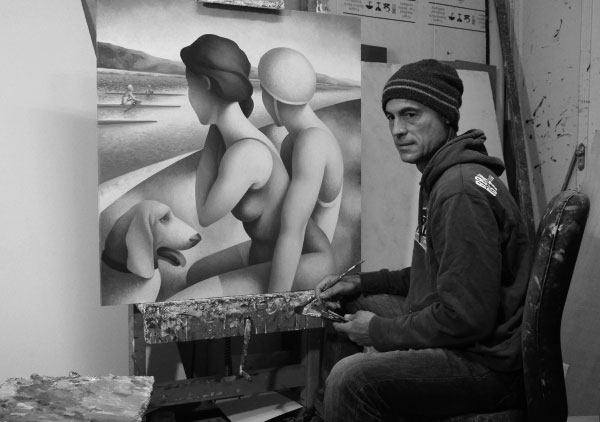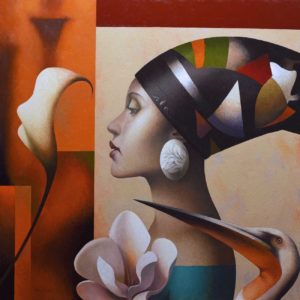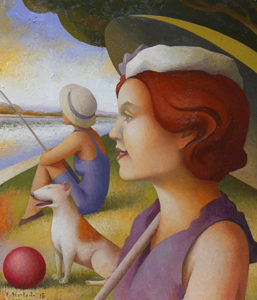MADRID, 1960 Fabio Hurtado

The pictorial universe of Fabio Hurtado is located in the United States of America of the twenties and thirties of the last century, with scenes and characters that refer us to the canvases of Edward Hopper and Tamara de Lempicka as well as the films The Great Gatsby and Bonnie & Clyde.
It paints a time that hardly any of us has known, but it does not matter, since he knows how to capture a historical spirit that, to this day, is not only valid, but even necessarily defensible.
FABIO HURTADO- THE SECRET GARDEN
by Imma Pueyo
Fabio Hurtado exhibits again in the Sala Rusiñol a group of paintings in which he integrates works from the series The secret garden with others that are part of the latest works based on the idea of interculturalism, understood by the artist as the interaction of cultures of ancestral roots and the signs that make up modernism, art déco, music, theater, cinema and the artistic avant-garde. The Secret Garden, the generic title of the exhibition, is therefore the bridge between the past and the present where transversal culturalism stands out, manifesting itself more intimately, with a sensitivity close to the spiritual and with a certain air of recovery of some approaches. aesthetics expressed in previous works.
The motif behind the exhibition is the human figure, a recurring theme and object of the painter’s creative experiences, depicted frontally, almost always adorned with a hat, imagined in a secret garden, a utopian dream place where nature and humanity merge. in a silent love In his current work, he represents men and women of color, in profile portraits, frozen in time, against an abstract background, with birds and flowers, significant objects that give the subject plastic depth and symbolic content. These profile images point us to Egyptian art, African art, archaic cultures and also show affinities in typology like the Renaissance painters Piero della Francesca or Pisanello among others.
Drawing is the main instrument to transfer your visual perceptions, your ideas and the fantastic imagined world. The line is precise, defines the entire figuration, combines geometric shapes with more gestural lines and tends to represent objects in a way that stimulates the imagination. In the plastic space, through drawing and constructive geometry, he achieves forceful aesthetic effects from formal associations as if they were sequences of musical or poetic rhythms. Fabio Hurtado is a great colorist and his technique is exceptional in modeling spherical shapes and simplified volumes, often giving them a sculptural appearance. The color has a special treatment that characterizes the artist’s style: it is worked with layers of paint on a textured background and stands out for its power and luminosity.
Each painting involves a long execution time as it requires both a conceptual and procedural preparation process. But for Fabio Hurtado painting is part of his life. It is not an evasion. Through the magnificent images we can take a journey through some movements and stylistic trends in the History of Art, evoking Renaissance profiles, the immobility of ancient Egyptian art, Cubist geometries, the elegance of Art Deco, the chromatic stripes of Paul Klee. or African art. The painter refers to an intercultural context beyond borders and would like to blend everything in harmony. His works of art are created with a contemporary spirit uniting the human being and nature with the hope of achieving an ideal planet.
THE PAST THAT LOOKS AT THE FUTURE OF FABIO HURTADO
by Josep M. Cadena
The pictorial universe of Fabio Hurtado is located in the United States of America in the 1920s and 1930s, with scenes and characters that refer us to both the canvases of Edward Hopper and Tamara de Lempicka and the films The Great Gatsby and Bonnie & Clyde. The women wear cloche hats and short bob cut hair, they dress with modernity and elegance and exhibit independence. The presence of means of transport -Coche, train, airplane, transatlantic- supports the assertion of the futurist Marinetti that a racing car can be more beautiful than the Victory of Samothrace. The animals provide the virtues and characteristics that are their own, so the dog expresses fidelity and the peacock symbolizes glamor. If we pay attention to playing the pictures we will clearly hear jazz, the music that reigned in the Cotton Club.
Fabio Hurtado paints a time that hardly any of us has known, but he gives, since he knows how to capture a historical spirit that, to this day, is not only valid, but even necessarily vindicable. The twenties came after the cataclysm of World War I, and the thirties suffered the depression that arose from the financial crack of 1929. The reaction to the planetary war was the awakening of a desire to live, the understanding that the life is a fragile gift that has to be missed. At the same time, the economic shock that began with the collapse of the stock market generated the adoption of the New Deal, a new political pact that understood the need to control big capital, reduce social differences and move towards a system of protection for the most destitute.
We are also emerging from a crisis. That is why the paintings of Fabio Hurtado, and the values they convey, despite being set in the past, are fully current. The women who paint have confidence in themselves, they are not afraid of the trip, and although they appreciate the company, they know how to go through the world all by themselves. They are seen in continuous movement, since the adventure of knowledge and progress has no final stop. Women have traditionally been oppressed, and it is they who can best embody the society towards which we should aim. The community in which we have to want to live should be like the woman who paints the Spanish father and Italian mother: safe, kind, elegant, sensitive, restless and worried about improving.
I find it very fitting that the Rusiñol Gallery of Sant Cugat directed by Ignacio Cabanas and Victoria Ballbé celebrates its 30th anniversary with this exhibition by Fabio Hurtado, since both the gallery owners and the painter share a respect for the lessons of the past that should serve to live a present of what we can be proud of and aspire to an even better future. So be it.


